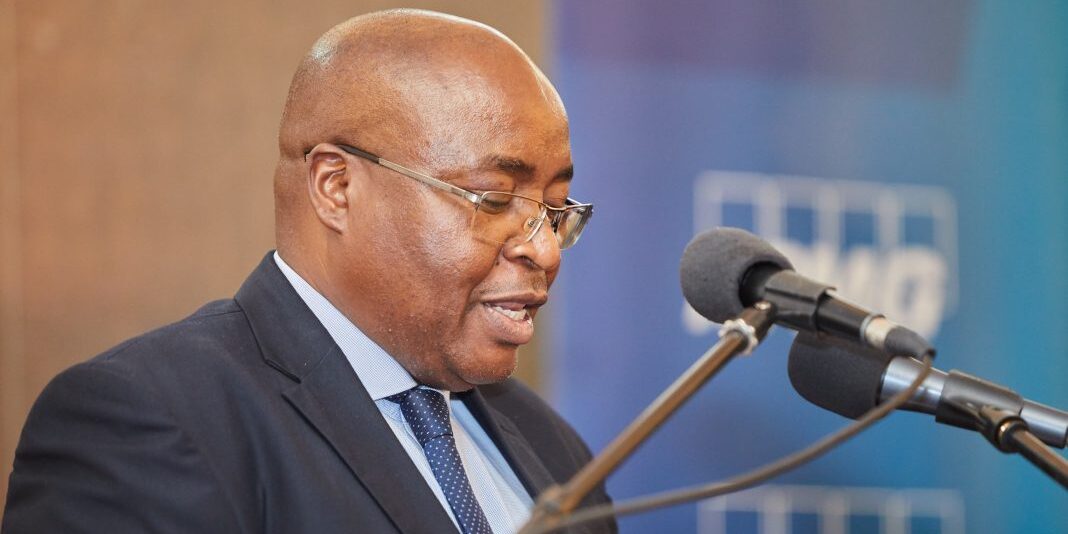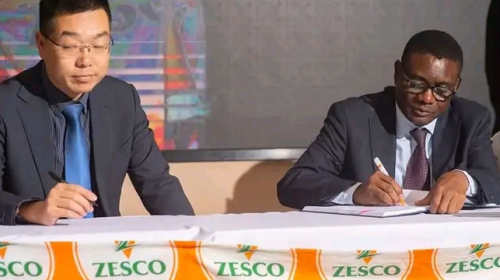Behind the 2021 Zambian National Budget- Michael Phiri explains
Enthusiasm was palpable during Friday’s reading of Zambia’s 2022 Budget by Minister of Finance, Hon. Mr. Situmbeko Musokotwane, who announced a wide range of intended measures to grow the economy and reign in overspending, several of which were met with cheers.
Mining For Zambia asked Michael Phiri, Tax Partner at KPMG Zambia, to share his insights on the most noteworthy developments in this year’s Budget announcement, and what they mean for Zambia and its citizens.
Were there any surprises, in terms of measures that you weren’t expecting the Minister of Finance to announce in this year’s Budget?
There were so many exciting measures announced, but the one that exceeded all my expectations was the drive to organise an IMF programme for Zambia as early as November 2021. I never imagined that this might happen before early next year, so this is very exciting.
What will an IMF programme mean for the country?
It is the key to unlocking our debt burden. If we can reach an agreement in November this year – fingers crossed! – then we may even be able to restructure one particular bullet payment of about $750 million that is due very soon, by accessing a cheaper loan from the IMF. That would immediately ease things.
Were there any other measures that you weren’t expecting?
Yes, the move towards decentralising Government operations was very audacious in my view, and was one of the major positives on the Budget’s expenditure side.
Please explain.
In the past, each of Zambia’s 156 constituencies relied on Central Government to fund all the projects in their constituencies – no matter how small. If a roof blew off, for instance, the member of parliament in that constituency would have to wait for someone from Government to travel from Lusaka to oversee its repair. This allegedly bred endemic corruption in the procurement of goods and services – with costs frequently exaggerated – and often led to decisions about which projects were prioritised being made on politically or tribally biased grounds. This meant that the majority of resources did not reach the intended beneficiaries.
Decentralising operations will go a long way to rectifying this. Allocations from the Constituency Development Fund will be increased from ZMW1.6 million to ZMW25.7 million for each constituency, which is significant in ensuring a more equitable distribution of resources. From a social impact perspective, this was a big measure, and the one that received the loudest cheers in parliament.
“This year’s announcement sparked a lot of excitement because, generally speaking, it resonated with the aspirations of the people.”
What were some of the other key takeaways in the Budget?
This year’s announcement sparked a lot of excitement because, generally speaking, it resonated with the aspirations of the people. To see Government really responding to areas of concern in the mining sector was a highlight. The fiscal changes they announced included the long-awaited removal of mineral royalty non-deductibility, and the Minister also expressed the intention to graduate the Mineral Royalty Tax (MRT) rates so that they increase incrementally, much like the way Pay As You Earn (PAYE) operates. The only downside is that the restructuring of MRT may only be passed into law in the medium term – possibly in early 2023.
Another problem area that was addressed is with restrictions on deductibility of interest for corporation tax purposes which was also really hampering investment in the mining sector.
Please explain?
If you invest in a mine through debt, and the interest costs on the debt exceed certain levels, a portion of your interest expense may be treated as non-deductible when calculating corporation taxes. Any interest treated as non-deductible can however be claimed in future. The carry forward period for this restricted interest was previously five years which, for a mining or energy producing company with large investment costs, is far too short to enable them to claim these interest costs. This carry forward period has now been extended to ten years, which helps companies to recover more of their investment costs, so this is an exciting change.
The Chamber of Mines has described this Budget as ‘a step in the right direction’ for minerals policy reform. Do you expect to see further action in the future?
If we look at Hon. Musokotwane’s credentials and his reputation as Zambia’s Minister of Finance [from 2008-2011] he is unequivocally pro-investment. He certainly doesn’t limit himself by looking at immediate or short termist taxes, at the expense of future growth.
I’m confident that the Minister will reverse old measures. He understands the need to create an environment that encourages investment and enhances productivity. We can expect the customs regime to return to the traditional structure of allowing capital equipment – highly specialised machinery that is not manufactured here – to come into Zambia duty and VAT free to encourage the development and construction of new mines and increased minerals production. Raw materials that are needed to support production which are not available in Zambia will likely be brought in with reduced tariffs, too.
Government’s production target of three million tonnes of copper per annum within a decade is both ambitious and commendable. Is the removal of non-deductibility – and the intention to implement a sliding scale for mineral royalty tax in the “medium term” – sufficient for attracting investment to enable this substantial increase in production?
Beyond those two planned measures, I think that the Government’s credibility and trustworthiness will be fundamental in helping investors decide whether or not Zambia is an attractive investment destination. The new Administration is portraying itself as consistent, and one that ‘walks the talk.’
Naturally, investors also look at how frequently the Government changes and, if the Administration is implementing measures that are successful and popular, that also helps to inform investors’ decisions. It’s these aspects – beyond the fiscal regime – that will help to bring in the investment that will lead to these production targets being reached.
“Beyond those two planned [mining] measures, I think that the Government’s credibility and trustworthiness will be fundamental in helping investors decide whether or not Zambia is an attractive investment destination. The new Administration is portraying itself as consistent, and one that ‘walks the talk.’”
You sound optimistic about the mining sector’s growth.
The level of growth needed to meet these production targets will require investment in new operations and the expansion of existing mines over a ten-year horizon. The changes that are promised will mean that, when companies model their projects and look at their recovery periods, most of these are bankable. In the past, getting projects to the bankable stage was impossible because the tax regime was not attractive enough to get investment in this jurisdiction, compounded by the risk discount due to years of fiscal instability.
I’m confident that additional fiscal changes, personal engagement with the sector, plus the new Government’s popularity are all factors that, in combination, will make investment decisions easier.
How do you expect outside investors – beyond the mining sector – to respond to the Budget announcement?
Government’s plan to revamp Zambia’s Multi Facility Economic Zones (MFEZ) signals a return to the thinking that originally inspired them: to have export-oriented businesses operating from industrial parks (and benefitting from certain tax concessions) to drive exports, create employment, earn foreign currency, and exploit markets in the region. That whole drive almost came to a complete halt under the last Government because I don’t think they appreciated the vision.
The MFEZ’s were originally set up on the current Finance Minister’s watch [when he served as Minister of Finance from 2008-2011]. Now, he can bring back this sense of ownership in driving this initiative again. I expect to see investors respond positively.

The theme of this year’s Budget speech was “Growth, jobs, and taking development closer to the people.” Did it live up to expectations in the “jobs” department?
Government has taken bold steps toward employment creation and there’s a strong skill development component, which will increase opportunities for formal employment in rural communities. The commitment to employing 44,000 teachers and healthcare personnel is audacious! For too long, we’ve measured how the economy is growing in terms of inflation, GDP, and exchange rate targets, and this Budget brings employment statistics into the spectrum as well. The measures announced to improve our agricultural competitiveness will also translate into job creation, of course.
Tell us more about the plans to focus on agriculture.
The plan to develop viable pieces of arable land into farm blocks is very promising. The previously abandoned Nansanga Farm Block, for instance, has a proposed budget of ZMW110 million allocated to its development which, in turn, will encourage private investment in the agriculture sector. The impact that this will have on Zambians in the medium and long term cannot be underestimated.
We know that mining is cyclical, with highs and lows in terms of prices. An economy like ours needs a diversified source of export earnings, so if we can also ramp up sectors like agriculture and tourism, that becomes very advantageous. The Minister has done well in diversifying our revenue mix, and this also speaks to the need to plan for the future, when mines inevitably close one day. For me, the focus on agriculture and agri-processing as a way of expanding the economy was sublime!
When it comes to the mammoth task of tackling Zambia’s debt burden, do the measures announced go far enough? The IMF, for one, has said that extreme fiscal prudence is required before it considers offering Zambia a programme.
The IMF is strong on social cash transfers, so one of its key desires is for Zambia’s social spend to reach the intended beneficiaries. The decentralisation that I have mentioned is very positive and should excite the IMF in the sense that Government is addressing the social needs of the populace. The question is: ‘Has Government done enough to access an IMF programme?’
A few weeks ago, the Government published Zambia’s official debt stock as of the end of June 2021. This satisfies another of the IMF’s pillars: transparency. From a fiscal prudence standpoint, we can see that spending is tight, corruption is being eliminated, and the focus is on available resources, and not contracting more debt when they run out. Domestic arrears are being dismantled – including the VAT refunds owed to many businesses; the appetite for issuing treasury bills and Government bonds has also been subdued. In short, the new Government is demonstrating fiscal prudence.
Beyond the IMF, what effect do you think the Budget announcement will have on multilateral support for Zambia?
In fact, all debt restructuring proposals are hanging in the balance, and are dependent upon whether the IMF gives us the nod of approval. If it does, then everybody else will come to the party. There is currently talk of the Chinese giving us a moratorium on debt repayments for three years, and there are also other parties that may be willing to restructure our commercial debt in order to give the Government a bit of breathing space to implement some of the projects it has planned.
The Minister of Green Economy and the President of the Republic of Zambia travelled to the United Nations Climate Change Conference in Glasgow (COP26), where I understand there were meetings lined up with some EU leaders. I mention this because ESG and climate change issues are key on the agenda of ‘the big guys’ in the big economies.
This year’s Budget includes deliberate steps to promote ESG-type activities – particularly the drive for solar projects – and, because of the way Zambia is addressing issues like climate change, there is certain to be some other multilateral support coming on its way to Zambia.
Another way of thinking about this is that, in Zambia, we produce copper primarily from hydro power, which is considered ‘green’. As a result, a conversation is being sparked at these fora around offering countries that produce minerals in a more environmentally friendly way a premium purchasing price, compared to those using other types of energy. The extent to which tax incentives for sectors like solar feature in this year’s Budget – and the fact that the new Government is attending climate change fora like these – could help to put Zambia on the map as a leading copper producer, as countries around the world embrace ESG.
![]()





